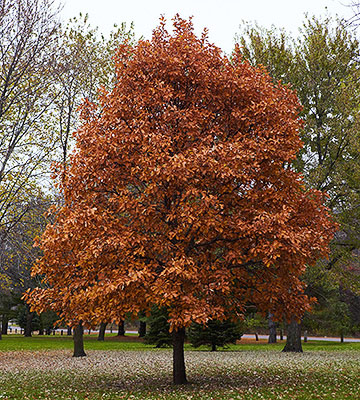Plant Shade Trees and Add Up the Savings

When the harsh summer sun beats down and temperatures soar, shade trees come to the rescue. These workhorses in the landscape do more than provide a place for you to cool down, though we won't minimize the importance of that. In addition to benefits such as improving air quality and providing beauty, their cooling effect translates to lower energy bills, a welcome relief for any homeowner.
A number of energy companies, nonprofits, municipalities, and other government agencies nationwide give away trees to homeowners or provide them at reduced costs in an effort to reduce energy demands and help the environment.
Place your shade trees in strategic locations in the landscape and you will be on your way to an environment that will help you save money. For example, plant trees on the west side of your home for cost-reducing shade in the summer.
According to the U.S. Department of Energy, shade trees can result in a 25 percent reduction in energy costs. That can amount to $100 to $250 annually. Trees also boost the value of your property by as much as 15 percent.
continue reading below
Top Sources for Budget-Friendly Trees
- The Arbor Day Foundation offers 10 free trees with a membership, which starts at $10. Visit the organization's website, www.arborday.org, to find several different packages. Some of the best for shade trees are the oak trees; the autumn classics package, which includes maples, oaks, and sweet gum; and the tree mix package, which includes spruce, birch, and several maples and oaks. Granted, the trees are seedlings, but the price is right. Planted in the right spot and given the proper care, the trees will provide shade in a few years.
- The Arbor Day Foundation Energy-Saving Trees Program: The Arbor Day Foundation works with utilities, municipalities, companies, and other organizations in more than 30 states as part of its Energy-Saving Trees Program. Often, utilities and others make trees -- ½ gallon to 7 gallon sizes -- available for free to their customers. The time of year to be on the lookout for free trees is during the spring months (March-May) or in the fall (September-November). Watch for bill inserts, local advertising, and media stories that alert homeowners about tree availability, or check with your local utility. You also can type in your address at the Arbor Day website to find out if your local utility participates in the program. "If you see ads, jump on the opportunity quickly and reserve your trees," advises Kristen Bousquet, with the Arbor Day Foundation. "It's a popular offering and the trees go quickly."
- The Alliance for Community Trees, a network of nonprofits across the country, lists groups nationwide that work with urban and community forestry efforts. Some of the groups have tree sales. To find a starting point near you, take a look at the Alliance's page, Who's Who in Your State.
- Your City: Most cities have a city or urban forester, usually located in the Public Works or the Parks and Recreation Department. In some cases, cities will plant trees at the edge of lawns next to streets to enhance the tree canopy of an area. If the city doesn't provide trees, often a city forester can put you in touch with local tree organizations that may sell at reduced costs.
- Some Conservation Districts (sometimes called Natural Resources Districts or Soil Conservation Districts) may offer trees that provide shade, along with trees that may be good windbreaks or provide wildlife habitat. It varies from district to district and state to state.
- County Extension Offices: In some locations, county Extension offices team up with the state forest service or other organizations to sell or give away seedlings.
- Arboretums: If you have an arboretum near you, inquire about community tree programs.
Tree Selection Advice
"The key when adding any tree to your landscape is to make sure the tree is healthy," says Dana Karcher with the Alliance for Community Trees. "Make sure the quality of the tree is good. Look for good branching structure and avoid rootbound plants and those with broken branches or nicked bark."
When adding a tree to your landscape, consider the location and the size of tree when fully grown. The last thing you want to do is plant a tree under utility lines and watch it grow, only to have to trim it back or remove it. Place trees in spots where they are free to grow to their natural size, giving you their best benefits.






